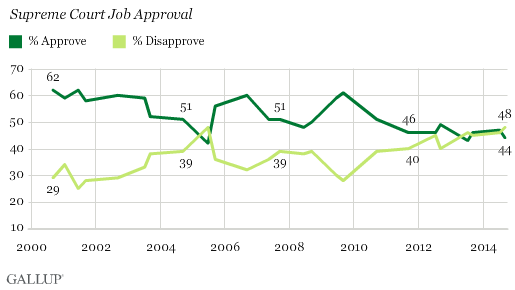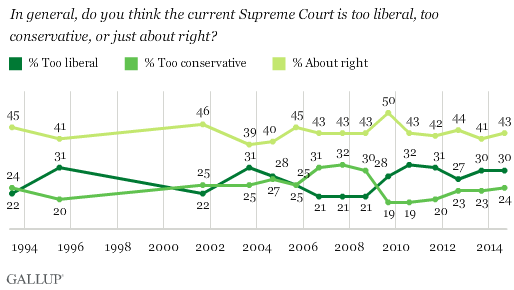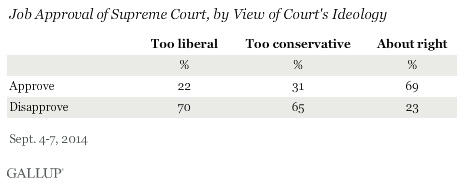PRINCETON, NJ -- As the Supreme Court begins a new term Monday, Americans' opinions of the job it is doing remain about evenly divided, with 44% approving and 48% disapproving. The public's views of the way the court is handling its job have generally been split since 2012. They were much more positive than negative prior to that.

The results are based on Gallup's annual Governance poll, conducted Sept. 4-7, and before Monday's announcement that the Supreme Court would not hear challenges to prior lower-court rulings that overturned bans on same-sex marriage in several states.
Gallup first asked Americans to assess the job the Supreme Court is doing using this question format in September 2000. At that time, 62% approved, which ranks as the highest rating to date. From 2000 through 2007, a majority approved of the Supreme Court, with one notable exception -- a 42% approval rating in June 2005, which ranks as the lowest to date. That record-low approval rating came shortly after a controversial decision in which the Supreme Court ruled that local governments could use the power of eminent domain to seize land from private homeowners for commercial development purposes.
In recent years, Americans have been less approving of the court, consistent with their reduced trust in government and their job approval ratings of federal government institutions. Still, during this time the Supreme Court's job approval rating has been about the same as or better than President Barack Obama's, and much better than Congress' approval rating. And Americans express significantly more trust in the judicial branch of the federal government than in the executive or legislative branch.
Republicans More Negative Toward the Supreme Court
Republicans have recently tended to have more negative opinions than other party groups of the way the Supreme Court is doing its job. Currently, 35% of Republicans approve, compared with 46% of independents and 47% of Democrats.
To a large degree, Americans' views of the Supreme Court appear to be influenced by the party of the president, as Republicans showed greater approval of the court during George W. Bush's presidency -- averaging 63% -- than they have under Obama's (40%). Likewise, Democrats' average approval rating of the Supreme Court has been 58% under Obama compared with 47% under Bush.
But partisans' opinions of the court also appear to be influenced by high-profile court decisions that are decided to their liking. This past summer, Republican approval surged to 51% after the "Hobby Lobby" case. Republicans' approval dropped and Democrats' approval rose after the Supreme Court upheld major provisions of the Affordable Care Act in 2012. And partisans' opinions of the Supreme Court were dramatically affected after the court effectively made Bush president in the legal dispute over the 2000 presidential election ballot recounts in Florida.
No Consensus on Court Ideology
Americans typically describe the ideology of the Supreme Court as "about right" rather than "too liberal" or "too conservative." This year, 43% say the court's ideology is about right, while 30% say it is too liberal and 24% too conservative. Throughout Obama's presidency, Americans have been more likely to describe the court as too liberal than as too conservative. During the second term of Bush's presidency, after he nominated two conservative justices to the court, Americans were more likely to say the court was too conservative.

As would be expected, those who are comfortable with the Supreme Court's ideology widely approve of the job it is doing, at 69%. Those who think the Supreme Court is too liberal or too conservative give the court low ratings of 22% and 31%, respectively.

Implications
Americans have clearly become less positive toward the Supreme Court in recent years, as they have toward other government institutions. Still, they view the Supreme Court as positively as, or more positively than, the other institutions of the federal government, as they typically have.
Americans do seem to pay some attention to what the Supreme Court is doing, as evidenced by changes in approval ratings after major decisions. Those changes are sometimes more evident in the approval ratings of Republicans and Democrats than in approval among the broader population, because the partisans' ratings often shift in opposite directions.
Survey Methods
Results for this Gallup poll are based on telephone interviews conducted Sept. 4-7, 2014, with a random sample of 1,017 adults, aged 18 and older, living in all 50 U.S. states and the District of Columbia.
For results based on the total sample of national adults, the margin of sampling error is ±4 percentage points at the 95% confidence level.
Interviews are conducted with respondents on landline telephones and cellular phones, with interviews conducted in Spanish for respondents who are primarily Spanish-speaking. Each sample of national adults includes a minimum quota of 50% cellphone respondents and 50% landline respondents, with additional minimum quotas by time zone within region. Landline and cellular telephone numbers are selected using random-digit-dial methods. Landline respondents are chosen at random within each household on the basis of which member had the most recent birthday.
Samples are weighted to correct for unequal selection probability, nonresponse, and double coverage of landline and cell users in the two sampling frames. They are also weighted to match the national demographics of gender, age, race, Hispanic ethnicity, education, region, population density, and phone status (cellphone only/landline only/both, and cellphone mostly). Demographic weighting targets are based on the most recent Current Population Survey figures for the aged 18 and older U.S. population. Phone status targets are based on the most recent National Health Interview Survey. Population density targets are based on the most recent U.S. census. All reported margins of sampling error include the computed design effects for weighting.
In addition to sampling error, question wording and practical difficulties in conducting surveys can introduce error or bias into the findings of public opinion polls.
View survey methodology, complete question responses, and trends.
For more details on Gallup's polling methodology, visit www.gallup.com.
